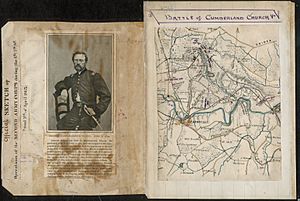Battle of Cumberland Church facts for kids
Quick facts for kids Battle of Cumberland Church |
|||||||
|---|---|---|---|---|---|---|---|
| Part of the American Civil War | |||||||
 Map shows the area between Farmville, Va., and Cumberland Courthouse to the north. This was a small skirmish just north of Farmville in Cumberland County on April 7, 1865, just following action at Highbridge and Rice's Station. |
|||||||
|
|||||||
| Belligerents | |||||||
| Commanders and leaders | |||||||
| Andrew A. Humphreys George Crook J. Irvin Gregg |
Robert E. Lee Thomas L. Rosser Thomas T. Munford |
||||||
| Units involved | |||||||
| II Corps Union Army Army of the Potomac, Cavalry Corps, Second Division |
Army of North Virginia | ||||||
| Strength | |||||||
| 12,000 | 12,000 | ||||||
| Casualties and losses | |||||||
| 645 | 255 | ||||||
The Battle of Cumberland Church was a fight during the American Civil War. It happened on April 7, 1865. The battle was between the Union Army and the Confederate States Army. It was part of the Appomattox Campaign, which was the final part of the war.
The Confederates won this battle. But it caused a delay that helped the Union Army win the war soon after.
Contents
What Happened at Cumberland Church?
The Retreat and High Bridge
After a big battle at Sailor's Creek, Confederate troops were trying to escape. They needed to cross the Appomattox River using a place called High Bridge. This bridge had a railroad track on top and a wagon road below.
The Confederates wanted to burn the bridge after they crossed. This would stop the Union Army from following them. But they were slow, and Union soldiers arrived just as they started burning it.
The Union soldiers fought to save the bridge. They managed to keep the wagon bridge usable. This meant Union troops could still cross the river.
Moving to Cumberland Church
After crossing, the Confederates headed towards Cumberland Church. This was about 4 miles (6 km) west of High Bridge. They started building defenses on high ground around the church.
More Confederate soldiers, led by General James Longstreet, joined them. They had just come from Farmville, Virginia. They burned the bridges at Farmville to stop the Union Army from following them there.
The Battle Begins
Union troops, led by Major General Andrew A. Humphreys, arrived at Cumberland Church. They attacked the Confederate lines. However, the Confederates were in a very strong position. They had good defenses on high ground.
Humphreys realized the Confederate position was too strong. He called back some of his troops. He also sent a message to his commander, Major General George Meade. Humphreys told Meade that General Robert E. Lee's entire army was at Cumberland Church. He asked for more Union soldiers to help attack.
But Humphreys and Meade didn't know that the Confederates had burned the bridges at Farmville. This meant no more Union soldiers could cross the river to help that afternoon.
More Attacks and Casualties
Humphreys heard fighting nearby and thought Union reinforcements had arrived. He ordered another attack, but it failed. A Union general, John Irvin Gregg, was captured by the Confederates during a cavalry fight.
Since no more Union soldiers could arrive, Humphreys stopped his attacks as night came. The Union II Corps had about 571 soldiers killed, wounded, or missing. The cavalry had 74 casualties. Confederate casualties were around 255.
Why Was This Battle Important?
Lee's Night March
General Robert E. Lee knew the Union forces were closing in. So, he decided to move his army again that night. They marched west around 11:00 p.m.
Even though the Confederates won the battle and had fewer casualties, the fight at Cumberland Church slowed them down. This delay was very important.
Grant's Message to Lee
While Lee was planning his next move, Union General Ulysses S. Grant sent him a message. Grant told Lee that his army's situation was hopeless. He asked Lee to surrender to avoid more fighting and deaths.
Lee replied that he didn't agree his situation was hopeless. But he also wanted to avoid more bloodshed. He asked Grant what the surrender terms would be.
The Road to Appomattox
The delay at Cumberland Church allowed other Union forces to move ahead of Lee's army. This helped the Union Army cut off Lee's escape route.
The next day, Union cavalry captured Confederate supply trains at Appomattox Station. This was a huge blow to Lee's army, which was running out of food. The delay also allowed more Union troops to reach Appomattox Court House.
Because of these delays and the Union forces surrounding them, General Lee was forced to surrender his army at Appomattox Court House on April 9, 1865. This effectively ended the American Civil War.

